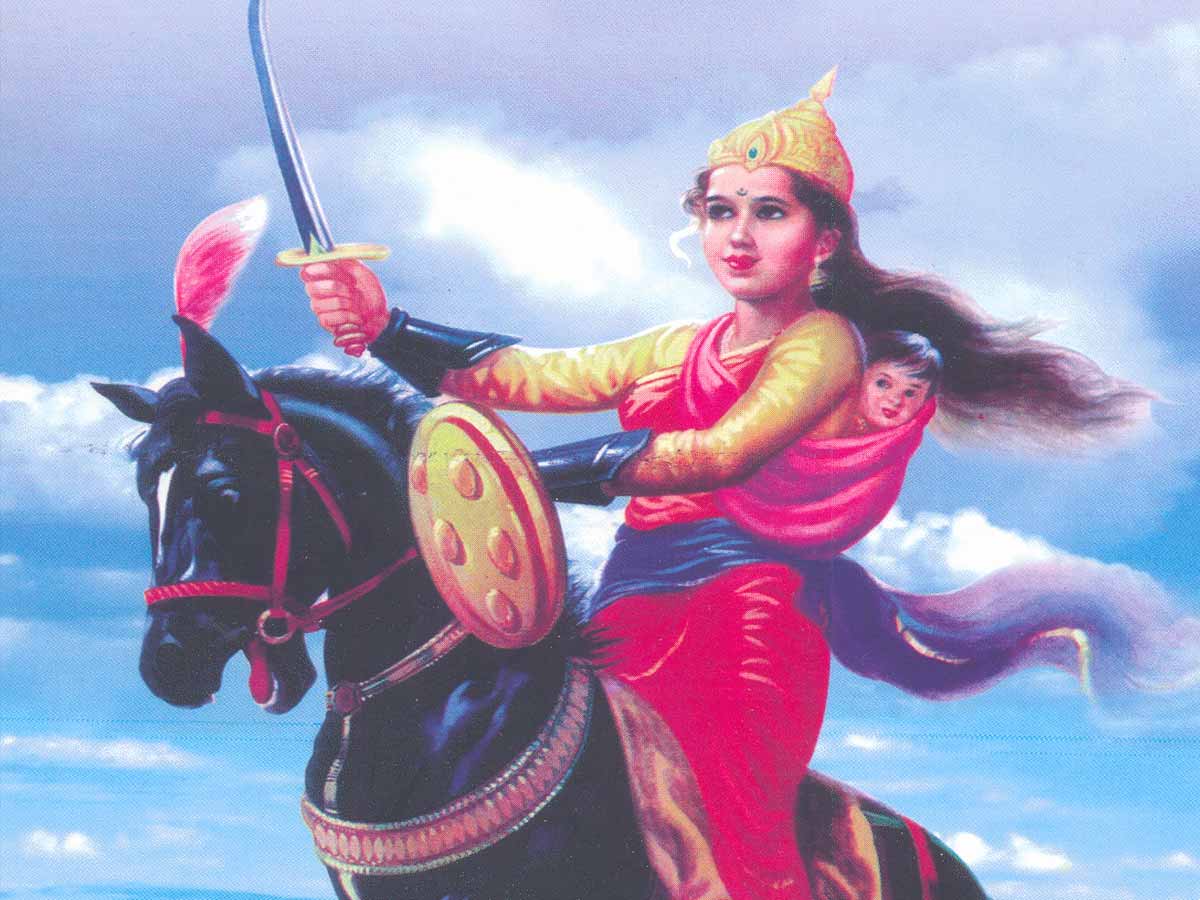Lakshmibai, Jhansi’s Rani (19 November 1828-18 June 1858), was an Indian queen who lived in the Jhansi district in Uttar Pradesh, India, of the Maratha princely state of Jhansi in North India. She was among the foremost characters in the Indian Revolt of 1857. She became a symbol of opposition to the British Raj.
Rani Lakshmibai was born into a Marathi Karhade Brahmin family in the town of Varanasi on 19 November 1828. Her name was Manikarnika Tambe, and her nickname was Manu. Her father was Moropant Tambe, and Bhagirathi Sapre was her mother. Her parents hailed from Maharashtra and settled here. When she was hardly four years old, her mother expired. Her father was a Kalyanpranth War Chief. Her father worked for Peshwa Baji Rao II in the district of Bithoor. She was named “Chhabili” by the Peshwa, which means “playful.”
She was educated at home. In her childhood, she was more independent than her age; her studies included shooting, horsemanship, fencing, and mallakhamba. Nana Sahib and Tatya Tope were her childhood friends. At this period in India’s culture, Rani Lakshmibai contrasted many patriarchal societal standards for women.
Supported by escorts between the palace and the temple, Rani Lakshmibai was used to traveling on horseback. According to chroniclers, her horses included Sarangi, Pavan, and Baadal; she rode Baadal when she fled from the fort in 1858.

The Rani Mahal, her palace, has now been converted into a museum. A collection of archaeological remains from the 9th and 12th centuries AD is housed here.
In May 1842, Manikarnika was married to the Maharaja of Jhansi, Gangadhar Rao Newalkar, and was later named Lakshmibai in honor of the Hindu goddess Lakshmi & also because of the tradition where the woman is given a new name after marriage by the Maharashtrian custom. She gave birth to a child named Damodar Rao in September 1851, who died four months after birth. A boy called Anand Rao, Gangadhar Rao’s cousin, who was renamed Damodar Rao, was adopted by the Maharaja on the day before the Maharaja died.
The British East India Company, under Governor-General Lord Dalhousie, applied the Doctrine of Lapse after the death of the Maharaja in November 1853 because Damodar Rao was an adopted son, opposing the claim of Damodar Rao to the throne and annexing the state to its territories. She shouted “Main apni Jhansi Nahi doongi” when she was told of this. Rani Lakshmibai was granted an annual pension of Rs. 60,000 in March 1854 and ordered to leave the palace.

The Indian Revolt began in Meerut on 10 May 1857. Rani asked the British political officer, Captain Alexander Skene, to raise a body of armed men for her protection, to which Skene agreed. Amid the regional unrest, the town was relatively peaceful. Still, in the summer of 1857, the Rani held a Haldi Kumkum ceremony with pomp in front of Jhansi women to provide assurance to her subjects and encourage them that the British were chickens and not to be scared of them.
Lakshmibai was reluctant to Revolt against the British until this point. In June 1857, the 12th Bengal Native Infantry rebels seized the Star Fort of Jhansi containing the treasure and armory. After persuading the British to lay down their arms by promising them no harm when they broke their word, Rani massacred 40 to 60 European garrison officers. The participation of The Rani in this massacre is still a matter of discussion.
The Sepoys left Jhansi four days after the butchering, earning a large sum of money from the Rani and warning to blow up the palace where she lived. Following this, the Rani felt obligated to assume the administration as the only source of authority in the city and wrote to Major Erskine, the Saugor division’s commissioner, describing the events that had led her to do so. Erskine replied on 2 July, demanding her to ‘manage the District for the British Government’ before the British Superintendent reported. The armies of Rani defeated the mutineers’ attempt to assert the claim to the throne of a rival prince, Sadashiv Rao, who was captured and imprisoned.

The forces of company allies Orchha and Datia then invaded Jhansi; their goal was to split Jhansi between themselves. The Rani appealed to the British for assistance. Still, the governor-general now claimed that she was liable for the massacre, and no reply was received. She set up a cannon casting foundry to be used on the fort walls. She mobilized armies, including those from former Jhansi feudatories and elements of the mutineers who were powerful to overpower the enemies in August 1857. At this time, her purpose was still to keep Jhansi on behalf of the British.





























